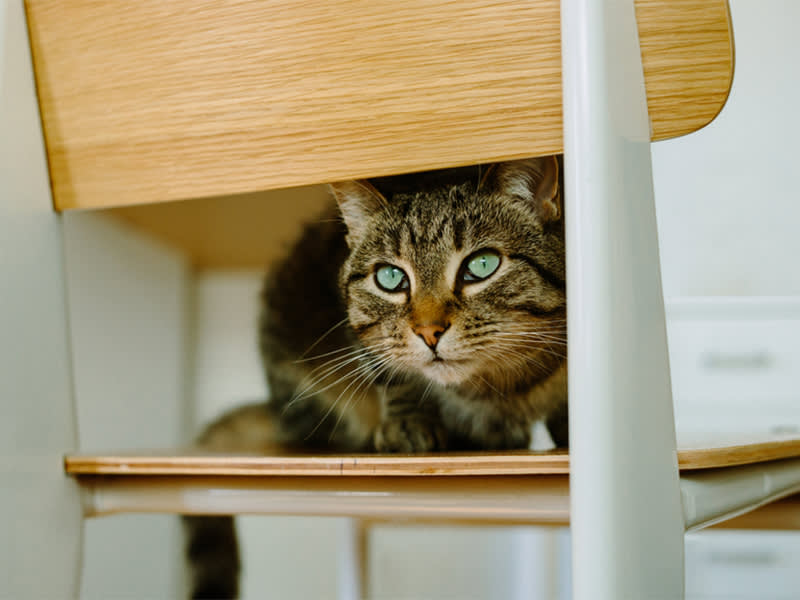How to Kitten-Proof Your House
A cat behaviourist’s 10 steps for keeping your cat out of trouble

Share Article
OK, so, you’ve done it. You’ve listed out your pros and cons and every last toy, treat and accessory you need. Now, you’re finally bringing home a cat. You can’t wait to have snuggle seshes on the couch and play fetch (yep, it’s not just for dogs). But cats are known for their curiosity, which means you can count on them getting into, well, everything – including, but not limited to, your curtains, precious heirlooms and your couch, which looks like an attractive scratching post. And as invincible as cats appear to be, they can actually hurt themselves in the process of exploring your home.
That’s why it’s crucial to cat-proof your place before you welcome them home. “Think of it as preparing your house for a new baby… if babies could jump,” says certified cat behaviourist Marilyn Kriegeropens in new tab. “Some breeds, like Bengals and Savannahs, are good at opening doors, while Maine Coons are really smart – they watch and learn from people.” And kittens of any breed are mischievous, albeit adorable, little beasts. Safeguard your cat – and your stuff – with Marilyn’s cat-proofing tips.
1. Keep breakable objects out of reach
Anything fragile (or important to you) should be tucked away in a cabinet until you can trust your cat not to knock it over.
2. Anchor unsteady or top-heavy furniture to the wall
Think: flat-screen TVs, wobbly bookshelves, or anything else that can fall on top of a cat who has attempted to scale it. A baby-proofing anti-tip kit can help.
3. Cover your cords, cables and phone chargers
Cats love to chew stringy things, so to avoid the dangers of electricity, secure your cables with electrical tape. On that note, don’t leave out any actual string, balls of wool, elastic bands, dental floss, hair ties... the list goes on. “You do not want them playing with any of that,” says Marilyn. “They can easily strangle themselves or ingest it.”
4. Make sure your windows are secure
If your cat is going to be an indoor cat – or just for the first weeks while they’re settling in – then you may want to install a screen across your windows if you open them often. When it comes to blind cords, tie ’em up or simply cut them. Window treatments without looped cords are safest for cat households.
5. Toss or give away any poisonous plants
Many plants and flowers are toxic to cats – especially lilies, irises, poinsettias and sago palms. Safe alternatives are orchids and African violets – your cat can nibble on them with abandon (if you don’t mind).
6. Close or lock kitchen cupboards
Many human foods are also toxic to pets, including chocolate, grapes and raisins. “Don’t let your cat clean your plate,” says Marilyn. And don’t forget the potentially dangerous medication, vitamins or supplements in your bathroom cabinets.
7. Put away household cleaners
Chemical cleaners, bleach and pine-and phenol-based cleaners can poison your cat, so be sure to keep them in secured containers in a cabinet. And if your cat has access to your garage, keep the anti-freeze well out of reach – it smells sweet to animals but is highly toxic.
8. Keep any and all receptacles covered
That means trash cans lidded, washer/dryer doors shut, and toilet seats down – basically, anything that a cat can jump or fall into. And plastic trash bags, for that matter, are just as dangerous: some cats like to play with them as much as cardboard boxes, so don’t leave them lying around after you put away the food shop.
9. Cat-proof your couch
To protect your sofa and furniture from becoming a scratching post, cover those surfaces and reinforce with double-sided sticky tape. Then, put an actual scratching post nearby so your cat can indulge their instincts somewhere appropriate (not your vintage loveseat). And get rid of your recliner. Sorry to your dad’s favourite chair. Marilyn warns that cats often get caught underneath.
10. Hide away sharp objects
That magnetic knife rack that makes you feel like a profesh chef? Not super-safe for cats who like to prowl the kitchen late at night. Also hide away scissors and razors.
It’s a lot, we know. Fur, spills, hairballs and more dubious messes are par for the course of being a pet parent. But these precautions will keep your new cat (and your entire house) safe.

Kellie Gormly
Kellie B. Gormly is an award-winning journalist based in Pennsylvania who writes for many national publications, including The Washington Post, Woman's World, Catster, and Dogster. Kellie is a volunteer rescuer who fosters kittens and cats at her home, where she has several of her own cats and betta fish.
Related articles
Can Cats See Colour?
Short answer: yes – but not the way we do
Cat Allergies: Do Hypoallergenic Cats Exist?
If the sniffles are getting you down, don’t stress: you have options
![A gray cat in a tan cat carrier]()
Your Cat Doesn’t Have to Hate Their Carrier
A behaviourist’s six surefire steps to training a cat to go in a carrier
![Training a cat sitting with leash and harness on.]()
A Step-by-Step Guide On How to Clicker Train Your Cat
This popular training technique isn’t just for dogs. Here’s how you can make it work for your cat





